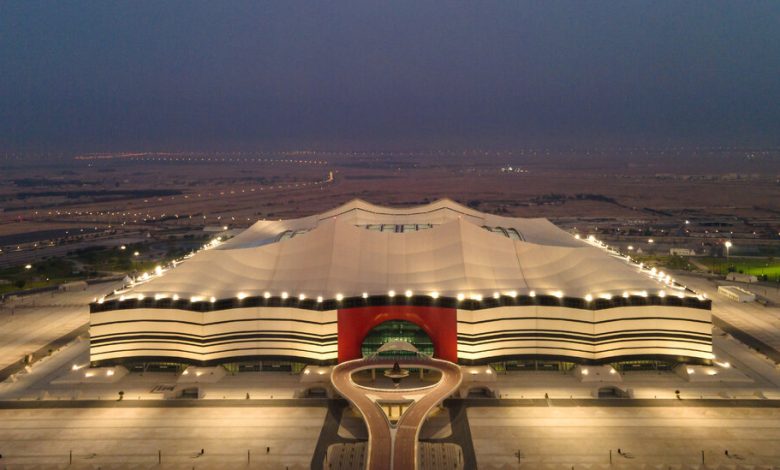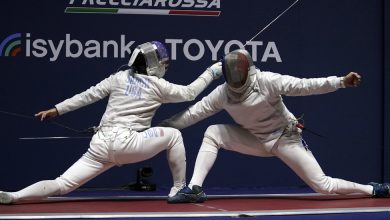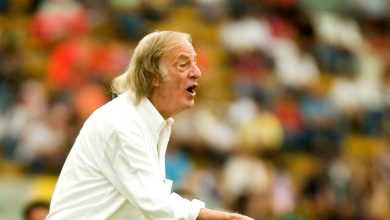Stadiums as High Art in a World Cup Fantasyland

AL KHOR, Qatar — It’s hard to convey how strange it is to come upon Al Bayt Stadium, an enormous stylized tent decorated with black stripes, for the first time. Designed for the World Cup as a homage to traditional nomadic dwellings, Al Bayt, the centerpiece of a manicured park 22 miles north of Doha, rises as if from nowhere and seems at once apt and incongruous, spectacular and otherworldly — an oasis in the desert, or maybe just a mirage.
Completed just last year, Al Bayt is one of seven new stadiums built for the World Cup in and around Doha, the capital of Qatar. (An eighth is a spruced-up version of an old stadium.) Each is more spectacular, more unexpected than the next. Each contributes to the relentless sense of cognitive dissonance that pervades this World Cup.
Qatar spent a reported $220 billion preparing for the tournament, conjuring new buildings, new neighborhoods and even an entirely new city. To be here now is to exist in a bubble of high unreality: a place in which everything is newer and better, and which exists, for the time being, only in reference to itself.
On match days, it takes nearly an hour by bus to get to Al Bayt. All of the other stadiums are easily reachable on the underground metro system, or connected to it by free buses, so this has become a commuters’ World Cup, an event more reminiscent of an Olympics than previous tournaments. In Russia in 2018, for instance, some fans had to travel to Yekaterinburg, nearly 1,000 miles from Moscow, for a handful of matches. In Brazil four years earlier, the trip from Manaus to Pôrto Alegre was more than twice as far.
But here you can visit all the stadiums in a single day.
Take the train west on the green line, for example, past the Qatar National Library (architect: Rem Koolhaas), and you find yourself in Education City, a 2,900-acre campus comprising schools, research centers and incubators. Walk a little way along the path and there is the 40,000-seat Education City Stadium, looming like a spaceship from a superior civilization whose inhabitants have a taste for bling. During the day, it changes color as the sun moves across the sky; at night, disco-style lights streak across it, fueled by thousands of diodes.
A Brief Guide to the 2022 World Cup
What is the World Cup? The quadrennial event pits the best national soccer teams against each other for the title of world champion. Here’s a primer to the 2022 men’s tournament:
Where is it being held? This year’s host is Qatar, which in 2010 beat the United States and Japan to win the right to hold the tournament. Whether that was an honest competition remains in dispute.
When is it? The tournament opened on Nov. 20, when Qatar played Ecuador. Over the two weeks that follow, four games will be played on most days. The tournament ends with the final on Dec. 18.
Is a winter World Cup normal? No. The World Cup usually takes place in July. But in 2015, FIFA concluded that the summer temperatures in Qatar might have unpleasant consequences and agreed to move the tournament to the relatively bearable months of November and December.
How many teams are competing? Thirty-two. Qatar qualified automatically as the host, and after years of matches, the other 31 teams earned the right to come and play. Meet the teams here.
How does the tournament work? The 32 teams are divided into eight groups of four. In the opening stage, each team plays all the other teams in its group once. The top two finishers in each group advance to the round of 16. After that, the World Cup is a straight knockout tournament.
How can I watch the World Cup in the U.S.? The tournament will be broadcast on Fox and FS1 in English, and on Telemundo in Spanish. You can livestream it on Peacock, or on streaming services that carry Fox and FS1. Here’s how to watch every match.
When will the games take place? Qatar is three hours ahead of London, eight hours ahead of New York and 11 hours ahead of Los Angeles. That means there will be predawn kickoffs on the East Coast of the United States for some games, and midafternoon starts for 10 p.m. games in Qatar.
Got more questions? We’ve got more answers here.
Along another metro line is the colorful Stadium 974, whose name is a nod to the (impossible to verify) number of shipping containers said to be used to build it and also Qatar’s international dialing code. Stadium 974 is both original and witty, and it is scheduled to be dismantled at the end of the tournament. (Are World Cup matches more fun if they’re played in an arena that appear to be constructed from Legos? Discuss.)
It’s fun to think of the things the stadiums look like. Khalifa International Stadium has a dramatically swooping upper rim that brings to mind a Möbius strip. (Next to it is a striking spear-like building thrusting into the air that my colleagues guessed might be a control tower, a telecommunications hub or “something to do with falconry” but that turns out to be a hotel.)
At Al Janoub Stadium, the pinkish, gently undulating roof is meant to evoke the “wind-filled sails of Qatar’s traditional dhow boats,” according to the World Cup guide, but instead has become known for evoking the same sort of thing as the flower paintings of Georgia O’Keeffe. (“It’s really embarrassing,” the stadium’s architect, Zaha Hadid, who died in 2016, said when the comparison first came up. “What are they saying? Everything with a hole in it is a vagina? That’s ridiculous.”)
Get back on the metro and take the green line to the last stop, the Mall of Qatar. There you’re faced with two equal and opposing forces. Behind you is the mall itself, a vast temple to retail and entertainment. In front of you, girdled in the evening by a glowing royal blue band of light, is the imposing Ahmad bin Ali Stadium, known as the Gateway to the Desert because of the barren landscape that rolls out into the distance just beyond it. Not everyone is a fan: Architectural Review described it as “a vast object planted in the desert by the whirlwind of cash that swirls around FIFA.”
That is the problem, or one of them, with the mere idea of the Qatar World Cup: the majesty intertwined with the folly. The exploitation of migrant laborers employed to build its bespoke arenas; the shipped-in grass and the ornamental trees in places where these things do not grow; the sense that the infrastructure, rich in detail and high design, is meant to create future need, not meet one in the present; the way it always feels too hot outside and too cold inside; the decorative water fountains in one of the driest places on Earth — all these things are hard to process.
The other evening, I took the metro to the Free Zone station. After a shuttle bus ride and a long walk, I turned the corner to see the gorgeous Al Thumama Stadium, twinkling like a diamond and silver crown, dramatic against the dark night sky.
“It’s my favorite stadium,” said Abdulrahman al-Mana, a Qatari who was working at the venue but whose regular job is in urban planning. He is 24 and went to Cornell, on tuition paid for by his government. He is proud of Qatar and proud of the stadium, which was designed by the Qatari architect Ibrahim Jaidah and evokes the gahfiya, the traditional woven cap worn by Arab men underneath their ghutras, or head scarves.
Al-Mana spoke passionately about how the stadiums would in many cases be reduced in size after the World Cup and then repurposed as community and sports centers, surrounded by parks and landscaping. “A big component of this is making sure there is a legacy for the future,” he said.
I thought about what he said as I took the metro in the other direction to the Lusail Iconic Stadium, at 88,000-plus seats the largest of Qatar’s stadiums, and the site of the World Cup final on Dec. 18. It’s a shiny bauble of a structure, an arrestingly beautiful giant golden vessel that somehow seems to absorb and generate and reflect light all at the same time.
The stadium is on one edge of Lusail, a city-in-progress 14 miles from central Doha. Though the city did not exist in anything resembling its current form as recently as 20 years ago, it is soon meant to hold 450,000 people and serve as a hub for sports, commerce, entertainment and tourism. Sure, it’s gorgeous, said an Azerbaijani man working at the tournament who did not want to give his name, but if I really wanted to see something, I should check out the four futuristic towers towering over the new city, glowing purple in the distance. He wasn’t sure what the towers were for — maybe they were only decorative — but suggested it was well worth my time: There is a huge shark there, he said.
Qatar is known to be passionate about collecting animals — the country just got two giant pandas from China, and it reportedly plans to build a park exclusively for giraffes in Lusail — and so it seemed plausible that it would install a shark tank in the middle of a vanity-project city.
Even though few people seem yet to live there, Lusail was teeming with crowds experiencing its particular brand of sensory overload. Cool air blew from the ground, due in part to a hulking cooling plant spewing steam next to the stadium. Inspirational songs blared from loudspeakers. Beams of light danced into the sky. Women dressed as giant red flowers walked around on stilts. Someone was playing Arabic music on a saxophone. The streets were lined with shops: Al-Jazeera Perfumes, a cafe called “Cup of Joe” and, for some reason, a Chuck E. Cheese the length of a city block.
The thoroughfare seemed to go on for miles. The towers at the far end turned out to be four Foster + Partners-designed office buildings, the future home of, among other things, the Qatar National Bank and the Qatar Investment Authority. The shark, suspended on cables between the buildings and glittering and twinkling with light like a disco ball, turned out to be fake.




